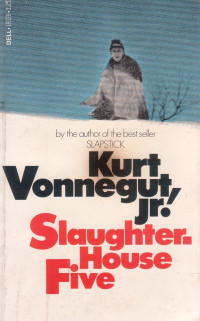Slaughterhouse-Five or The Children's Crusade. A duty-dance with death
Dell Publishing Co., Inc. - New York - 1969
for Mary O'Hare and Gerhard Müller
by Kurt Vonnegut, Jr.
A fourth-generation German-American
now living in easy circumstances
on cape cod
[and smoking too much],
who, as an american infantry scout
hors de combat,
as a prisoner of war, witnessed the fire-bombing
of Dresden, Germany,
"The florence of the Elbe,"
a long time ago,
and survived to tell the tale.
This is a novel
somewhat in the telegraphic schizophrenic
manner of tales
of the planet Tralfamadore,
where the flying saucers
come from.
Peace.
[ This is how the book starts, still before the story begins… ]
This book is a novel about the Second World War, but it is not like a history book or a precise reproduction of the facts that happened in that war. It is about life in and after the war and then especially in the fire-bombing of Dresden, Germany, because that is what the story is about most of the time: Dresden.
'Slaughterhouse-Five' stands for the building where one hundred American prisoners of war were housed. It was a cement-block cube with sliding doors in front and back. It had been built for pigs, but almost all the hooved animals in Germany had been killed and eaten by human beings, mostly soldiers. In case they got lost in the big city, they only had to remember the adress: 'Schlachthof fünf'.
Since there is not a real plot with a clear beginning and certainly not a clear end, it is quite difficult to give the outline and the chain of events. It is just the story of Billy Pilgrim's life, mainly after the Second World War.
Billy Pilgrim studied Optometry and married a girl he didn't really love, but she was the daughter of a rich optometrist. He married her for her family's money.
"He had been rewarded for marrying a girl nobody in his right mind would have married. His father-in-law had given him a new Buick Roadmaster, an all-electric home, and had made him manager of his most prosperous office, his Ilium office, where Billy could expect to make at least thirty thousand dollars a year. That was good. His father had been only a barber.
As his mother said, 'The Pilgrims are coming up in the world.' " p. 119
He also names his son Robert in the book, but he speaks more about his daughter, Barbara. She thinks he's crazy and interprets everything he does in a wrong way. After an aircrash he's gone through, he lays down but he has a housekeeper and his daughter visits him almost every day. Since the accident, he sometimes talks about his journeys to Tralfamadore, and then Barbara really thinks he is insane. If you hear the stories he tells about Tralfamadore, you'll remark that it is a totally different world. (see next fragment)
This book is full of flashes forwards and flashes backs. This is due to Billy's experience on Tralfamadore. He can see moments when he wants to see them, and that is why the story isn't chronological: all the events pass through each other and that makes this book a little chaotic.
"The most important thing I learned on Tralfamadore was that when a person dies he only appears to die. He is still very much alive in the past, so it is very silly for people to cry at his funeral. All moments, past, present, and future, always have existed, always will exist. The Tralfamadorians can look at all the different moments just the way we can look at a stretch of the Rocky Mountains, for instance. They can see how permanent all the moments are, and they can look at any moment that interests them. It is just an illusion we have here on Earth that one moment follows another one, like beads on a string, and that once a moment is gone it is gone forever.
'When a Tralfamadorian sees a corpse, all he thinks is that the dead person is in bad condition in that particular moment, but that the same person is just fine in plenty of other moments. Now, when I myself hear that somebody is dead, I simply shrug and say what the Tralfamadorians say about dead people, which is 'So it goes.'" p. 26-27
Because this book is about war, many people in our story die. Everytime that happens, Billy really always says 'So it goes.' Here are some examples.
"He was sentenced to six months in prison. He died there of pneumonia. So it goes." p.41
And Billy had seen the greatest massacre in European history, which was the fire-bombing of Dresden. So it goes." p. 101
…
…
The book takes place in different places and it takes several years (more than 25 years), so it is very difficult to indicate time and place. You could say that most of the time is spent in Germany, but a lot of time is spent back in America. Place and time are undefinable.
"There are almost no characters in this story, and almost no dramatic confrontations, because most of the people in it are so sick and so much the listless playthings of enormous forces. One of the main effects of war, after all, is that people are discouraged from being characters." p. 164
In the book are no "round" characters, says the author, but on the other hand, there are so much! I can't discuss them all, but I'll name some of the most important:
· Robert Pilgrim, his son: he joins the Green Barrets
· Barbara Pilgrim, his daughter: she looks after him now he is ill, but she would rather send him to an old men's home
· Valencia, his wife: (see fragment about her)
· Mary O'Hare: a trained nurse and wife of Bernard V. O'Hare, his friend from the war, whom he went visiting to remember some facts about the war
· Gerhard Müller: a cab driver, who took them to the slaughterhouse (he has been a prisoner of the Americans for a while)
· Roland Weary: an antitank gunner, with whom he joined the regiment
· poor old Edgar Derby: a high school teacher who was shot in Dresden
· Eliot Rosewater: a man who joined him in the hospital
· Montana Wildhack: a famous moviestar who is taken to Tralfamadore, too
· …
The fragment of Tralfamadore I like the most is their explanation about sex, for they can see in four dimensions on Tralfamadore.
"There were five sexes on Tralfamadore, each of them performing a step necessary in the creation of a new individual. They looked identical to Billy - because their sex differences were all in the fourth dimension.
One of the biggest moral bombshells handed to Billy by the Tralfamadorians, incidentally, had to do with sex on Earth. They said their flying-saucer crews had identified no fewer than seven sexes on Earth, each essential to reproduction. Again: Billy couldn't possibly imagine what five of those seven sexes had to do with the making of a baby, since they were sexually active only in the fourth dimension.
The Tralfamadorians tried to give Billy clues that would help him imagine sex in the invisible dimension. They told him that there could be no Earthling babies without male homosexuals. There could be babies without female homosexuals. There couldn't be babies without women over sixty-five years old. There could be babies without men over sixty-five. There couldn't be babies without other babies who had lived an hour or less after birth. and so on.
It was gibberish to Billy. p. 114
I liked the language of the book, especially because it was not too difficult, but also because that sort of language fits with the book. Normal soldiers do not speak eloquently or scientifically, they just speak fluently, and the book was also written more in spoken than in written English.
The leaps he took in the time were a little bit more difficult to follow.
I didn't really enjoy reading this book because of …. At first I was interested in the theme. I thought I would enjoy reading about the war, not the facts, but particularly the stories of the people behind the lines, the people who really had to fight and had to take risks to save their lives and that from others. They have really got to tell something, they have gone through a hell, suffered a lot. But this book was different, it didn't really tell a story about the war. It told a story about a man who had fought in the war, it told his life after war, his life now. It wasn't that interesting I thought it would be.
What I do like about the book is the fact that flying saucers take him to Tralfamadore, a planet where everything is totally different. I really enjoyed that parts of the book, they had some crazy ideas of life which were always surprising and funny.
It was very hard for me to make this book review, because there isn't really a plot, there aren't really characters. It was difficult to analyze the book.
I didn't like the way of Vonnegut's writing, but I really liked his ideas of flying saucers and the planet he has taken me to!







REACTIES
1 seconde geleden
E.
E.
ik zit met een probleem en misschien kun je me daarbij helpen als je daar zin voor hebt zou je dat van slaughterhouse five eens voor me willen vertalen tegen morgen ik heb vijdag examen overdat boek en vind het nogal moeilijk om het te vertalen dank bij voorbaat
groetjes ellen
23 jaar geleden
AntwoordenN.
N.
sterft billy,en hoe word hij gkidnapt door ruimtewezens?
20 jaar geleden
AntwoordenY.
Y.
heel mooi verslag,, maar je hebt hem zeker niet in het Nederlands? zou wel handig zijn :D
18 jaar geleden
Antwoorden